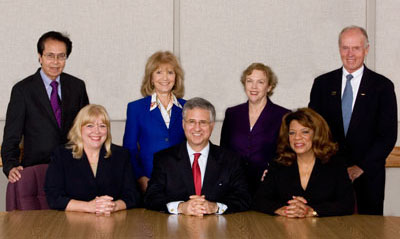Palm Beach County commissioners agreed in a workshop Tuesday to eliminate or combine some of the county’s 23 advisory committees, and in some cases put more emphasis on public forums for input on issues.
Although the county operates nearly 90 different committees, the ones under consideration are those that exist totally at the discretion of the commission and do not tie in with some other agency.
The commissioners asked for a report on the committees after a number of committee members resigned when Sunshine Law regulations were tightened, putting some of the members in conflict with other governmental roles.
County Administrator Bob Weisman said that there are three broad issues the commissioners must discuss: whether there are any boards they want to discontinue, whether there is a desire to reduce the number of at-large assignments, and whether they want to reduce the number of appointees per board.
“When this has been discussed previously, the discussions have been problematic,” Weisman said. “You’ve gotten objections from members of the boards that you might want to consider terminating, even when those boards have not always met, because they have constituencies.”
Board members have also objected because they simply like having the recognition, although the committees might no longer serve a necessary purpose, Weisman said, adding that most of the boards were developed with some function in mind. The question for the commission is if that function is still valid.
At-large appointments allow commissioners to consider certain qualifications of appointees, such as an engineer, attorney or doctor, to meet specific requirements of the respective boards, and ask for nominations from outside professional groups.
“The most challenging part is the constituencies that exist,” Weisman said, using an example of the Fire-Rescue Advisory Board and the Fire-Rescue Level of Service Committee. “Clearly, right now to me it seems there’s no reason to have the Fire-Rescue Level of Service Committee any longer. I think the importance of that has faded, it hasn’t met in a while and the need for it is probably no longer what it once was.”
The Handicapped Accessibility Awareness Grant Review Committee has not met in almost three years, but there are plans for it to meet soon because it is responsible for allocating grant money expected to become available this year.
Weisman said the Impact Fee Review Committee is interesting because it is specified in the comprehensive plan and the Uniform Land Development Code, which would require amendments to those documents to remove the committee. For that committee’s role, he believes the commission should replace its input with input from public forums instead.
The commission has discussed, but not eliminated, the 31-member Overall Economic Development Program Committee, which has not met in three years. “Many of the reasons for its existence, which were federal and state funding arrangements, have faded and no longer exist,” Weisman said.
One board that has no specific purpose but functions well with staff is the Water Utilities Advisory Board. “They’ve been in existence for 30 years, and some of the members have been there a very long time,” Weisman said. “It serves a role in advising Water Utilities staff on anything ranging from rate changes to how we’re going to treat our plants. It is not a necessity, but nice to have.”
Commissioner Shelley Vana said after reviewing minutes from some of the committees, what they are doing has no relation to what they were charged with. As an example, she said the Citizens’ Advisory Committee on Health & Human Resources is actually a committee of experts rather than citizens. Meanwhile, the Emergency Medical Services Advisory Council has a long list of things it is charged with but not doing. “They’re doing CPR training,” Vana said. “It’s supposed to provide trauma agencies with recommendations, and they’re doing CPR training.”
Vana said resolving all the issues is a bigger job than they had anticipated, and recommended that sunset reviews be considered individually for some of the committees, a half-dozen or so a year, so that they can be taken on a case-by-case basis.
Vana agreed that some of the committees could probably be combined, and that some of the functions should more appropriately be addressed through public forums. She also pointed out that all the members have to go through expensive and time-consuming ethics and Sunshine Law training. “If we had a public forum for these things, there wouldn’t be an issue with people not being a part of the committee,” she said.
Vice Mayor Priscilla Taylor was concerned about eliminating some of the committees because their members feel a fulfillment of purpose. “Citizens want to be involved in government,” she said. “I just want us to be cautious that the people who sent us here want to be involved.”
Mayor Steven Abrams agreed with Vana’s suggestion to go through a handful of the committees each year to look at them, not necessarily with the theme of eliminating them. “There are many purposes that they serve, and there are people who are very dedicated,” he said, adding that he would like to make sure that their mission is up to date and that their structure is correct.
Commissioner Paulette Burdick said the volunteers who serve on committees provide services that the county could not provide otherwise, although she agreed that the fire-rescue committees should be merged and the Impact Fee Review Committee could probably be sunset and its functions moved to public forums. “Current members of the committee could provide input at public meetings,” Burdick said.
Commissioner Mary Lou Berger agreed there should be a systematic review of all the committees, adding that it would be helpful to get a complete report of what the committees’ missions are, who the members are, what the attendance is and how often they meet.
ABOVE: The Palm Beach County Commission.








